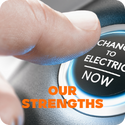Let's begin!
Principles
Ampere, kilowatt, kilowatt hour, AC charging, DC charging, etc. There is a lot to consider. Don't be intimidated by all those definitions and new terms. A good understanding of the terms kilowatt and kilowatt hour will go a long way. And we are here to explain it all to you in plain language!
Kilowatt
Kilowatt is the power of a charge point. The higher, the faster you can charge. Charging at home via a standard socket is the slowest (2.3 kilowatts). A charge point or charging station at home or public can deliver between 3.7 and 22 kilowatts. So then charging is 5 to 10 times faster. In domestic environments, it is often even up to 11 Kilowatts.
Roadside fast chargers do even better. But the maximum charging speed is also limited by the inverter in your car. That inverter is only the limiting factor for AC charging. The power can be set in the ‘vehicle settings’ or via the ‘charging station settings’.
Battery kilowatt-hour
The battery in kilowatt-hours is your ‘tank capacity’. The figure is the amount of electricity your battery can store. With an 80 kilowatt-hour battery, you will theoretically have power for about 4 hours or 400 kilometres, with an average consumption of 20kWh. This does depend on your driving style and average speed, the weight of your vehicle and the weather, with temperature playing a big role. Tyre pressure, tyre size and more specifically tyre width also have an immense impact on consumption. All these factors affect how far you can drive much more than with a diesel or petrol vehicle.
Kilowatt-hour consumption
A typical electric car consumes about 20 kilowatt hours or less. The lower, the more economical. Battery capacity divided by consumption gives you the range. With an 80-kilowatt-hour battery, you can drive for about 4 hours or 400 kilometres. This is an ‘ideal’ standard that tends to be lower in practice. The higher your speed, the higher your consumption. So on the motorway, you consume considerably more than in the city. Also, try not to drive the battery completely empty. This is not so good for the health of your battery.
Maximum charging capacity
The maximum charging capacity is the power your car can receive to charge its battery. Not every charge point has the same charging capacity. This is important for fast charging on long trips. If you do a lot of long trips, pay attention to this when making your choice. The energy from a fast charger goes directly to the battery and does not need to go through the inverter in your car. As a result, your vehicle can handle a higher charging capacity with a quick charger than through another charging point.
State of Health (SoH)
The State of Health of your battery is the charge your battery can still store. This decreases a little every year, but the impact is rather limited. It depends on the battery technology in your vehicle and your charging behaviour. Frequently fast charging, continuously- pushing the limits of battery capacity can wear out the battery faster. The optimal state of charge is between 20 and 80%.Is your car stationary for several days? Then be sure not to charge it higher than 80% and make sure there is a wide margin above 20%, because every battery loses energy, even when stationary.
Charging time
Charge time is battery capacity divided by charge rate. Charging 88 kilowatt hours at 11 kilowatts takes 8 hours. The last 20% charge slowly. This is another reason why it is better not to charge fully on the road, but at most 80% or less, as long as you make it to your destination worry-free.
Watt, Ampère, Volt
All terms that, as a layman, you don't really need. Ampere is current and indicates how many electrons are flowing through a device and Volt indicates how much energy each of these electrons carries. Watts indicate how much energy a device actually uses per second. Therefore, for your electric vehicle, this is the most important unit to consider.
AC/DC
Electronic devices operate on direct current - DC. The mains supply alternating current - AC. So it has to be converted via an inverter. An inverter is either in your car or in the charging station. An inverter in the charging station charges faster, but it is considerably more expensive. That's why you only find them in fast charging stations or sometimes at work. For DC, it is the battery technology and BMS (battery management system) that controls the power.
CCS and CHAdeMO plugs
CCS is the standard for DC charging. French and Asian cars used to have CHAdeMO plugs. These are different and not compatible with CCS. Sometimes you can still find CHAdeMO charging points at public stations. But the plugs are easy to distinguish.
Step 1
First steps
What range do I need?
What you need depends on your personal situation, of course. What we can tell you is that you shouldn't just rely on the figures the manufacturer indicates as you can only achieve this range in optimal conditions. To get a good idea of your actual range, multiply the indicator by 0.8. So 100km becomes 80. If you want more certainty in winter, multiply by 0.8 again. 80km then becomes 64km. The most prudent scenario is that you get 70% of the indicated range in all conditions.
So what are the most useful options?
One of the most important tips we can give you is that classic air conditioning and heating require a lot of energy. This can easily save you 10 to 20km in range. That is why it is a good idea to get seat heating and steering wheel heating, but also to opt for a heating pump. These all require less energy from the battery.
Something that people often overlook: tyres also have a big influence. A standard size will require much less energy than a wider version, and an open rim will require more energy than a closed version.
What should I take into consideration at public charging points?
When using an electric car, it's best to change some of your routines. Driving on an almost empty battery empty does not work too well with an electric car. Preferably, you plug in the car every time you are stationary for an extended period.
If you do not charge at home, it is also only polite to move your car as soon as it is sufficiently recharged; even at work.
What about a Home Charging Point?
A charge point at home? There are some considerations involved. To give an example: do you live with someone who also has a company car? Then it is likely that you will both need a charge point soon. But how do you arrange that with both employers? And what about your electricity consumption or your responsibility when something goes wrong with the charge point? And what if, in a few years, you can fill up with electricity from your company car for your consumption at home...?
Don't decide in haste. A charge point like this will last at least six to seven years and by then a lot will probably have changed. The cheapest solution today may be something you regret tomorrow. So be sure to get good advice.
Is an electric car always an automatic?
An electric car is ALWAYS automatic. It takes some getting used to and being careful not to apply the brakes fully when you think you are about to disengage.
But trust us, it doesn't take long before the blissful feeling of automatic driving kicks in!
Does the acceleration speed take some getting used to?
With an electric car you immediately get all the energy you need. If you don't have to switch gears, you will of course be off to a flying start. That's a nice feeling, but take it easy in the beginning. You don't want to lose control, especially in rain or snow.
Our tip: first get used to it before you stomp through your chassis with your right foot!
Is there a greater risk of fire and electrocution?
We can reassure you: these risks are no higher than with diesel or petrol cars. However, if the battery of an electric car does catch fire, the fire is very difficult to extinguish. The vehicle must be completely submerged in a water basin for several days.
Electrocution is also not a risk. Water, snow, the car wash or using a garden hose to wash your car... no problem! The battery disconnects in milliseconds, cutting off the power supply.
Assistance
We are here for you!
Is there an Ethias Lease Drivers App?
Of course!
You can download our Drivers App via the links below:
Where can I change my summer/winter tyres?
I have a flat tyre, where should I go?
My windscreen is damaged. Where should I go?
My car has broken down and I need a tow truck. What should I do?
If breakdown assistance is included in your contract: call Ethias Lease Assistance on + 32 2 210 97 97.
I've had an accident, what should I do?
Injuries or agression?
Contact the emergency services 112 by phone or via the app.
Material damage?
Complete the accident report.
Collect the necessary evidence
Take pictures of the damage and position of the vehicule.
Gather contact details of the other party and any witnesses.
In need of a tow truck?
Call Ethias Lease Assistance on +32 2 210 97 97
Report the accident to the police
Send us the accident report, pictures and contact details via ethiaslease@aon.be
I am seeking to contact Ethias Lease customer service.
Call + 32 2 210 96 96
Where can I have my maintenance done?
Book an appointment with an authorised dealer of the brand of your vehicle.
In which countries can I travel with my green card?
See the green card.
How will my green card be sent to me?
By email. Do not forget to print the document and place it in the vehicle.
I need to go for a technical inspection, what should I do?
Ethias Lease will send you a letter inviting you to attend the technical inspection. Make an appointment online or by telephone with an approved inspection centre.
Make sure you have your registration number and chassis number to hand.
Am I entitled to a replacement vehicle during servicing?
You are entitled to a replacement vehicle if a replacement vehicle is included in your contract and the maintenance takes longer than 24 hours.







